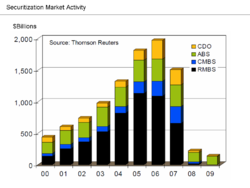Causes

A credit crunch is often caused by a sustained period of careless and inappropriate lending which results in losses for lending institutions and investors in debt when the loans turn sour and the full extent of bad debts becomes known. [1] [2]
There are a number of reasons banks might suddenly stop or slow lending activity. For example, inadequate information about the financial condition of borrowers can lead to a boom in lending when financial institutions overestimate creditworthiness, while the sudden revelation of information suggesting that borrowers are or were less creditworthy can lead to a sudden contraction of credit. Other causes can include an anticipated decline in the value of the collateral used by the banks to secure the loans; an exogenous change in monetary conditions (for example, where the central bank suddenly and unexpectedly raises reserve requirements or imposes new regulatory constraints on lending); the central government imposing direct credit controls on the banking system; or even an increased perception of risk regarding the solvency of other banks within the banking system. [3] [4] [5]
Easy credit conditions
Easy credit conditions (sometimes referred to as "easy money" or "loose credit") are characterized by low interest rates for borrowers and relaxed lending practices by bankers, making it easy to get inexpensive loans. A credit crunch is the opposite, in which interest rates rise and lending practices tighten. Easy credit conditions mean that funds are readily available to borrowers, which results in asset prices rising if the loaned funds are used to buy assets in a particular market, such as real estate or stocks.
Bubble formation

In a credit bubble, lending standards become less stringent. Easy credit drives up prices within a class of assets, usually real estate or equities. These increased asset values then become the collateral for further borrowing. [6] During the upward phase in the credit cycle, asset prices may experience bouts of frenzied competitive, leveraged bidding, inducing inflation in a particular asset market. This can then cause a speculative price "bubble" to develop. As this upswing in new debt creation also increases the money supply and stimulates economic activity, this also tends to temporarily raise economic growth and employment. [7] [8]
Economist Hyman Minsky described the types of borrowing and lending that contribute to a bubble. The "hedge borrower" can make debt payments (covering interest and principal) from current cash flows from investments. This borrower is not taking significant risk. However, the next type, the "speculative borrower", the cash flow from investments can service the debt, i.e., cover the interest due, but the borrower must regularly roll over, or re-borrow, the principal. The "Ponzi borrower" (named for Charles Ponzi, see also Ponzi scheme) borrows based on the belief that the appreciation of the value of the asset will be sufficient to refinance the debt but could not make sufficient payments on interest or principal with the cash flow from investments; only the appreciating asset value can keep the Ponzi borrower afloat. [9]
Often it is only in retrospect that participants in an economic bubble realize that the point of collapse was obvious. In this respect, economic bubbles can have dynamic characteristics not unlike Ponzi schemes or Pyramid schemes. [10]
Psychological
Several psychological factors contribute to bubbles and related busts.
- Social herding refers to following the behavior of others, assuming they understand what is happening. [6] As John Maynard Keynes observed in 1931 during the Great Depression: "A sound banker, alas, is not one who foresees danger and avoids it, but one who, when he is ruined, is ruined in a conventional way along with his fellows, so that no one can really blame him." [11]
- People may assume that unusually favorable trends (e.g., exceptionally low interest rates and prolonged asset price increases) will continue indefinitely.
- Incentives may also encourage risky behavior, particularly where the negative consequences if a bet goes sour are shared collectively. The tendency of government to bail out financial institutions that get into trouble (e.g., Long-term Capital Management and the subprime mortgage crisis), provide examples of such moral hazard.
- People may assume that "this time is different", which psychologist Daniel Kahneman refers to as the inside view, as opposed to the outside view, which is based on historical or better objective information.
These and other cognitive biases that impair judgment can contribute to credit bubbles and crunches. [6]
Valuation of securities
The crunch is generally caused by a reduction in the market prices of previously "overinflated" assets and refers to the financial crisis that results from the price collapse. [12] This can result in widespread foreclosure or bankruptcy for those who came in late to the market, as the prices of previously inflated assets generally drop precipitously. In contrast, a liquidity crisis is triggered when an otherwise sound business finds itself temporarily incapable of accessing the bridge finance it needs to expand its business or smooth its cash flow payments. In this case, accessing additional credit lines and "trading through" the crisis can allow the business to navigate its way through the problem and ensure its continued solvency and viability. It is often difficult to know, in the midst of a crisis, whether distressed businesses are experiencing a crisis of solvency or a temporary liquidity crisis.
In the case of a credit crunch, it may be preferable to "mark to market" - and if necessary, sell or go into liquidation if the capital of the business affected is insufficient to survive the post-boom phase of the credit cycle. In the case of a liquidity crisis on the other hand, it may be preferable to attempt to access additional lines of credit, as opportunities for growth may exist once the liquidity crisis is overcome.
